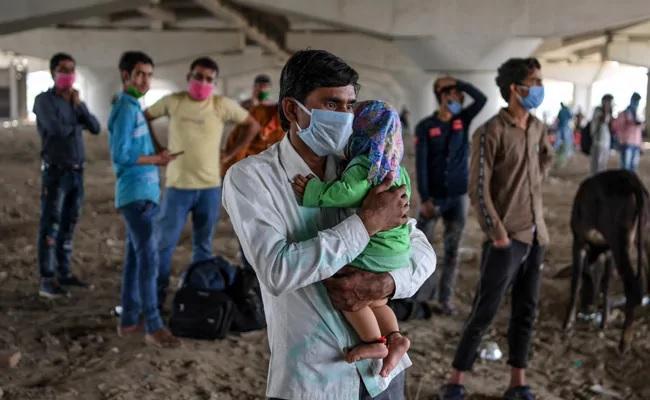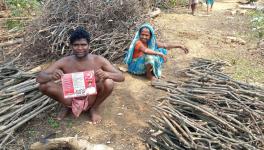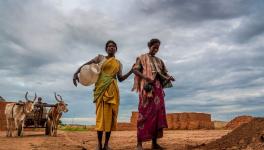How to Tackle a Pandemic During Community Transmission

Representational image. | Image Courtesy: NDTV
Late last week, three public health associations, including one member of a government advisory committee to contain the pandemic, wrote an open letter questioning the Prime Ministers Office for not consulting a wider range of experts when containment and mitigation strategies against the Novel Coronavirus were being drawn up.
Their letter has come at a time when there are gathering doubts that community transmission has made the viral disease spread across all the states of India.
Many Indians would share the doubts and misgivings of the health experts, because of the sheer pace at which cases of Covid-19 are increasing. India had 500 cases and a death toll of eight on 24 March but now, in the tenth week of a stringent lockdown, over 2.27 lakh are infected and around 6,500 have died.
Besides, there are harrowing reports of many of the sick being unable to access treatment in hospitals across the country. The toll in terms of infections and deaths along with the creaking public healthcare services is creating an impression that the system is getting overwhelmed by the pandemic. Yet, through all of this, the government has been insisting that there is no community transmission of the disease. In other words, the official claim is that in each of the 2 lakh-odd positive cases of Covid-19, the source of the infection has been traced and identified.
In fact, the Ministry of Health and Family Welfare is hiding behind the smokescreen that it will conduct its own testing and then determine whether community transmission has taken place. It has said that it will go public with its findings next week.
Dr Vikram Patel, a former professor at the Department of Global Health and Social Medicine at Harvard Medical School does not find the situation at all reassuring. “The horse has already bolted,” he says. “The infection is spreading and that is a matter of great concern,” he adds.
The Ministry of Health has been citing the small percentage of deaths to claim that community spread of Covid-19 is not taking place in India. It argues that the 3.4 deaths per million population being reported (as on May 30) are among the lowest figures in the world.
But Dr Patel believes that two other factors helped India on this score. The first is that unlike the West, where morbidity levels have been high due to sizeable elderly populations, India has a young population which can better withstand the virus. The other factor is that India has a largely outdoor population. During the summer, in villages and towns, a large number of people spend time outdoors. “In the West, everyone is indoors thereby increasing the chances of infection,” he says.
Top healthcare experts believe that the infection rate in India will peak in early July, which is a good month away, and not a day can be left to chance considering the huge public health risks involved.
There is an added complication, says Dr Ramanan Laxminarayan, director of the Centre for Disease, Dynamics, Economics and Policy in Washington. First, it is difficult to follow the trajectory of the Novel Coronavirus which causes the Covid-19 disease. Second, there is “not one Indian epidemic”. There is “a Maharashtra epidemic, a Gujarat epidemic, a Tamil Nadu one and a Delhi one…”
Yet, because of the quickening of the pace of the spread of Covid-19 in India, there is an urgent need for a coordinated national response to it. There is no doubt that the disease is spreading at different rates in different parts of the country. But there is little doubt that some uniform measures need to be taken across the country. Instead, each Indian state has framed a response quite in its own way.
For example, the Delhi government has mandated 117 public and private hospitals to treat Covid-19 patients, but non-Covid patients have been left to fend for themselves. “Several patients have died because of the lack of timely medical interventions,” says Malini Aisola, co-convenor of the All India Drug Action Network.
Another growing issue is that the line between Covid and non-Covid respiratory infections is getting extremely blurred. The result is that private hospitals are charging very high rates for treatment of Covid-19, especially for the PPE kits used by medical staff. This alone can cost a patient more than Rs. 10,000 a day and the numbers of patients in growing.
Fact is, PPE kits are going to be part of the regular safety precautions that all hospitals will have to mainstream—quite like the safety measures for HIV-AIDS or hepatitis that were introduced in the past. But the cost of PPEs will have to be regulated along with capping the prices charged by hospitals. This will have to be done, as Aisola says, for all patients during this pandemic, and right across the country. “Charging patients for PPE kits places an [especially] unfair burden on their shoulders since this is a universal precaution that must be practised during this health crisis,” she says.
In West Bengal, private hospitals have been requisitioned by the state which will reimburse treatment of Covid-19 patients at fixed rates. In Ahmedabad, despite the Gujarat High Court’s warnings, hospitals continue to overcharge patients. In Maharashtra, the government has capped charges for 80% of the beds in private hospitals while for the remaining 20%, the hospital is free to charge regular rates.
In Mumbai, the Jan Swasthya Abhiyan (JSA) wrote on 1 June to the BMC chief, Iqbal Singh Chahal, on behalf of several nursing and paramedical groups, highlighting their dismal work conditions. The letter states: “Mumbai is undoubtedly the country’s biggest hot spot and 1,500 MCGM [Municipal Corporation of Greater Mumbai] workers have contracted Covid-19, [while] 25 have succumbed to the virus...”
The JSA has said that despite representations to hospital authorities the working conditions had not improved, which prompted nearly 200 nurses to quit their jobs and return to their home state, Kerala, from fear of being infected. The letter says that when “an ordinary person gets infected with covid-19, nurses take care of them. When nurses get Covid-19, there is no one for us.”
Brinelle D’Souza, who teaches at the Tata School of Social Sciences, is one of the petitioners in a Public Interest Litigation in the Bombay High Court seeking directions to the state government that non-Covid patients should not be turned away by hospitals, which has become a common occurrence during the lockdown.
Mumbai’s peculiar issue is that its containment zones are located in low-income areas. In Dharavi, for instance. This sprawling settlement has 1,500 people to one public toilet. So tiny are the living quarters here that they are rented out to workers on a shift basis. D’Souza illustrates the living conditions of people in Dharavi with an example: From 6 am to 6 pm, six people will occupy a shanty, which is then rented out to another six people, from 6 pm to 6 am. But with the sudden lockdown and ban on all movements, all twelve tenants would be forced to simultaneously occupy the tiny space they used to share in shifts.
On top of this, Dharavi residents have to buy water at exorbitant rates. Often families pay Rs. 3,000 per month for water. “With no jobs during the lockdown, who can afford these rates. Obviously, the migrant workers fled to return to their villages,” says D’Souza.
But it is not just Dharavi. A Mumbai-based resident doctor has released a video highlighting how three resident doctors at a ward in King Edward Memorial (KEM) hospital were struggling to care for 35 critical patients in one ward without nurses, ward boys or other support staff. It is only the three doctors who were providing patients medicines, feeding them and performing all other chores. “Everyone has run away,” one of the doctors says in the video. “We have made several calls describing our plight to the higher authorities to send some assistants but no one is listening,” the doctor says.
A similar situation prevails across several hospitals in India. In Uttar Pradesh, Aflatu, a Varanasi-based social activist who lost his wife to blood cancer in May, says that there were no senior doctors to attend to critically-ill patients at the Sir Sunderlal hospital on the BHU campus. He had to accompany his wife every week to the hospital where she was undergoing dialysis.
“The hospital was being run by resident doctors. My wife required a small surgical procedure which could not take place because there were no senior doctors available to do the operation,” he says. This is exactly the situation that the doctors in the video from the Mumbai-based hospital also reported.
Reports say that private hospitals are demanding deposits to the tune of Rs 6-7 lakh before they admit a Covid-19 patient. Health activists insist that since the pandemic is a public health emergency, there must be price caps on charges levied by private hospitals.
The result is that several patients are opting out of Covid treatment in hospitals, relegating themselves to suffer in their homes if they cannot afford the heft treatment costs.
Dr T Sundarraman, public health expert and former executive director of the All India People’s Science Network believes this “home treatment model is flawed and Covid-19 patients must be treated in hospitals.”
Sundarraman is also apprehensive over “...fudging of Covid-related deaths, with correct details not having being released in the public domain.” For instance, he is surprised by why the use of ventilators seems inadequate given the growing numbers of active patients in India.
Prof K Srinath Reddy, president, Public Health Foundation of India, insists that the only way to control numbers is to step up the micro-containment strategy across the nation. “We need to take containment measures in ward after ward, cluster after cluster, and follow this up with syndromic surveillance in order to prevent transmission,” he says.
In the two states that have contained the virus, Kerala and Andhra Pradesh, these measures were taken in quick time.
Reddy believes that contact tracing must also be increased, with the help of community volunteers. “These volunteers do not require any lengthy training. Anyone with slightest suspicion of influenza must be put in quarantine,” he says. The country needs to tackle the pandemic on a war footing. Proper hospitalisation arrangements need to be made for all those patients who need it. The Kerala model of handling this crisis is there before the rest of the country and needs to be emulated in every detail.
The author is a freelance journalist. The views are personal.
Get the latest reports & analysis with people's perspective on Protests, movements & deep analytical videos, discussions of the current affairs in your Telegram app. Subscribe to NewsClick's Telegram channel & get Real-Time updates on stories, as they get published on our website.
























